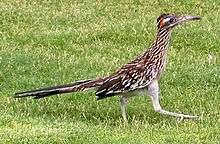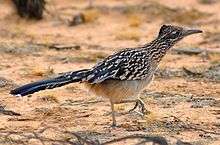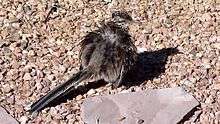Roadrunner
| Roadrunner | |
|---|---|
 | |
| Scientific classification | |
| Kingdom: | Animalia |
| Phylum: | Chordata |
| Class: | Aves |
| Order: | Cuculiformes |
| Family: | Cuculidae |
| Subfamily: | Neomorphinae |
| Genus: | Geococcyx Wagler, 1831 |
| Species | |
The roadrunner (genus Geococcyx), also known as a chaparral bird or chaparral cock, is a fast-running ground cuckoo that has a long tail and a crest. It is found in the southwestern United States and Mexico,[1][2] usually in the desert. Some have been clocked at 20 miles per hour (32 km/h).
Species
The subfamily Neomorphinae, the New World ground cuckoos, includes eleven species of birds,[3] while the genus Geococcyx has just two,[4] the greater roadrunner and the lesser roadrunner. The greater roadrunner, G. californianus, inhabits Mexico and the southwestern United States. The lesser roadrunner, G. velox, inhabits Mexico and Central America.[5][6]

Morphology
The roadrunner generally ranges in size from 22 to 24 in (56 to 61 cm) from tail to beak. The average weight is about 8–15 oz (230–430 g).[7] The roadrunner is a large, slender, black-brown and white-streaked ground bird with a distinctive head crest. It has long legs, strong feet, and an oversized dark bill. The tail is broad with white tips on the three outer tail feathers. The bird has a bare patch of skin behind each eye; this patch is shaded blue anterior to red posterior. The lesser roadrunner is slightly smaller, not as streaky, and has a smaller bill. Both the lesser roadrunner and the greater roadrunner leave behind very distinct "X" track marks appearing as if they are travelling in both directions.
Roadrunners and other members of the cuckoo family have zygodactyl feet. The roadrunner can run at speeds of up to 20 miles per hour (32 km/h)[8] and generally prefer sprinting to flying, though it will fly to escape predators. During flight, the short, rounded wings reveal a white crescent in the primary feathers.
Vocalization
The roadrunner has a slow and descending dove-like "coo". It also makes a rapid, vocalized clattering sound with its beak.
Geographic range

Roadrunners inhabit the deserts of the southwestern United States, Mexico, and Central America. They live in arid lowland or mountainous shrubland, widely dispersed in dry open country with scattered brush. They are non-migratory, staying in their breeding area year-round.[9] The greater roadrunner is not currently considered threatened in the US, but is habitat-limited.[10]
Food and foraging habits
The roadrunner is an opportunistic omnivore. Its diet normally consists of insects (such as grasshoppers, crickets, caterpillars, and beetles), small reptiles (such as lizards, collared lizards, and snakes, including rattlesnakes),[11] rodents and small mammals, spiders (including tarantulas), scorpions, centipedes, snails, small birds (and nestlings), eggs, and fruits and seeds like those from prickly pear cactuses and sumacs. The lesser roadrunner eats mainly insects. The roadrunner forages on the ground and, when hunting, usually runs after prey from under cover. It may leap to catch insects, and commonly batters certain prey against the ground. Because of its quickness, the roadrunner is one of the few animals that preys upon rattlesnakes;[12] it is also the only real predator of tarantula hawk wasps.[9]
Behavior and breeding
The roadrunner usually lives alone or in pairs. Breeding pairs are monogamous and mate for life,[13] and pairs may hold a territory all year. During the courtship display, the male bows, alternately lifting and dropping his wings and spreading his tail. He parades in front of the female with his head high and his tail and wings drooped, and may bring an offering of food. The reproductive season is spring to mid-summer (depending on geographic location and species).[9]
The roadrunner's nest is often composed of sticks, and may sometimes contain leaves, feathers, snakeskins, or dung.[14] It is commonly placed 1–3 meters above ground level[15] in a low tree, bush, or cactus. Roadrunner eggs are generally white. The greater roadrunner generally lays 2–6 eggs per clutch, but the lesser roadrunner's clutches are typically smaller. Hatching is asynchronous. Both sexes incubate the nest (with males incubating the nest at night) and feed the hatchlings. For the first one to two weeks after the young hatch, one parent remains at the nest. The young leave the nest at two to three weeks old, foraging with parents for a few days after.[9]
_2.jpg)
Thermoregulation
During the cold desert night, the roadrunner lowers its body temperature slightly, going into a slight torpor to conserve energy. To warm itself during the day, the roadrunner exposes dark patches of skin on its back to the sun.[9]

In popular culture
The Roadrunner appears as the primary protagonist in the Wile E. Coyote and The Road Runner cartoons by Warner Brothers, as part of the Looney Tunes series. The bird in the programme is based on the Greater roadrunner.[16]
A series of professional hockey teams in Arizona have been named after the bird, the most recent being the Tucson Roadrunners of the American Hockey League.
The mascot of the University of Texas at San Antonio is a roadrunner.
Notes
- ↑ "roadrunner". The Free Dictionary. Farlex. Retrieved 3 May 2012.
- ↑ "roadrunner". Merriam Webster. Retrieved 3 May 2012.
- ↑ Myers, P. R.; Parr, C. S.; Jones, T.; Hammond, G. S.; Dewey, T. A. "Neomorphinae (New World ground cuckoos)". Animal Diversity Web. University of Michigan. Retrieved 2009-08-12.
- ↑ Avian Web. "Roadrunners". Retrieved 3 May 2012.
- ↑ "Greater Roadrunners". Avian Web. Retrieved 3 May 2012.
- ↑ "Lesser Roadrunners". Avian Web. Retrieved 3 May 2012.
- ↑ "Roadrunner". Desert Animals. The Animal Spot. Retrieved 3 May 2012.
- ↑ Lockwood, Mark. Basic Texas birds: a field guide. Austin: University of Texas Press. pp. 168–169. ISBN 978-0-292-71349-9.
- 1 2 3 4 5 "Roadrunners". Avian Web. Retrieved 3 May 2012.
- ↑ Famolaro, Pete. "Greater Roadrunner (Geococcyx californianus)". California Partners in Flight Coastal Scrub and Chaparral Bird Conservation Plan. Point Blue. Retrieved 21 Aug 2015.
No federal or state [management] status. No other special status. Unitt (1984) indicates that roadrunners are habitat limited and have experienced a reduction in numbers due to urbanization.
- ↑ "roadrunner vs rattlesnake".
- ↑ "The Roadrunner". Desert USA. Retrieved 3 May 2012.
- ↑ "With the exception of breeding pairs, roadrunners are solitary (Hughes 1996). Pairs mate for life (Terres 1980)."
- ↑ "Information on the Roadrunner | The Nature Conservancy". Nature.org. 2016-07-15. Retrieved 2016-09-14.
- ↑ "Usually 1-3 meters above ground; infrequently higher than 3 meters (Hughes 1996)."
- ↑ Young, William (2014). The Fascination of Birds: From the Albatross to the Yellowthroat. Courier Dover. p. 251.
References
- Alsop III, Fred J. (2002). Birds of North America (1st American ed.). New York: DK. ISBN 0-7894-8001-8.
- del Hoyo, Josep; Baptista, Luis, eds. (1997). Sandgrouse to cuckoos. Barcelona: Lynx Ed. ISBN 84-87334-22-9.
- Harrison, George (2005). "Comical Cuckoo". Birder's World. 19: 56–58.
- Hutchins, Michael, ed. (2003). Grzimek's Animal Life Encyclopedia (2nd ed.). Detroit: Gale. ISBN 0-7876-5785-9.
- Meinzer, Wyman (1993). "Beep! Beep! Better pull over, folks – it's the roadrunner". Smithsonian. 23: 58.
- Perrins, Christopher M., ed. (1990). The Illustrated Encyclopedia of Birds: The Definitive Reference to Birds of The World (1st Prentice Hall Press ed.). New York: Prentice Hall Editions. ISBN 0-13-083635-4.
National Geographic, Society (2002). Field Guide to the Birds of North America (4th ed.). Washington D.C.: National Geographic. p. 244. ISBN 0792268776
Wetmore, Alexander; Kellog, Peter Paul (1965). Water, Prey, and Game Birds of Morth America. Washington D.C.: National Geographic Society.
Further reading
- Whitson, Martha A. (May 1983). "The Roadrunner: Clown of the Desert". National Geographic. Vol. 163 no. 5. pp. 694–702. ISSN 0027-9358. OCLC 643483454.
External links
| Wikimedia Commons has media related to Roadrunner. |
- Distribution map of the Greater Roadrunner
- Greater Roadrunner sounds
- Video clips of roadrunners in action
- ↑ National Geographic, Society (2002). Field Guide to the Birds of North America (4th ed.). Washington D.C.: National Geographic. p. 244. ISBN 0792268776.
- ↑ Wetmore, Alexander; Kellog, Peter Paul (1965). Water, Prey, and Game Birds of Morth America. Washington D.C.: National Geographic Society.